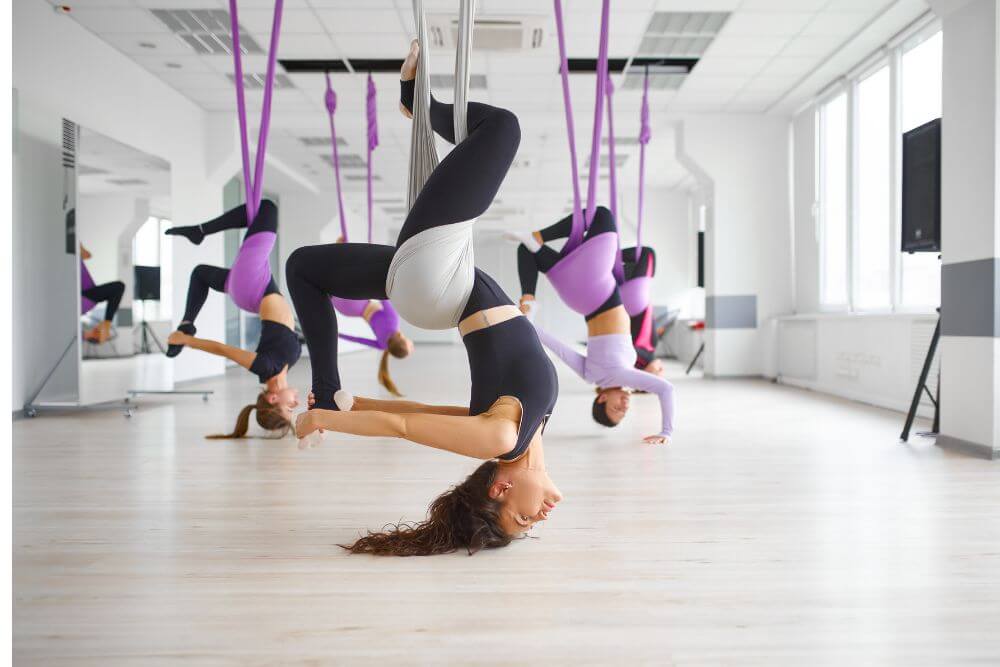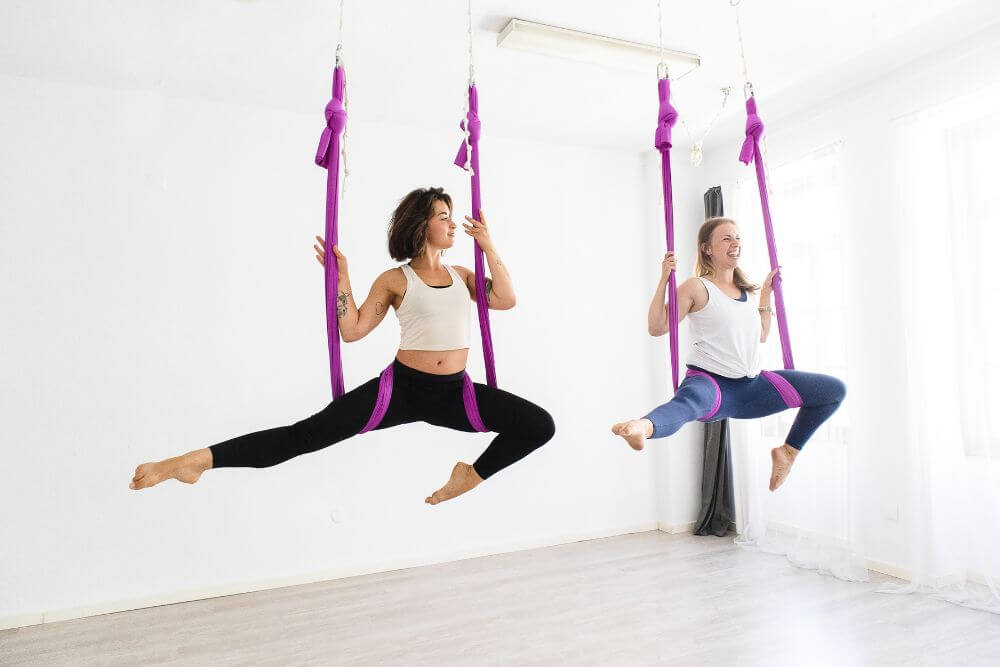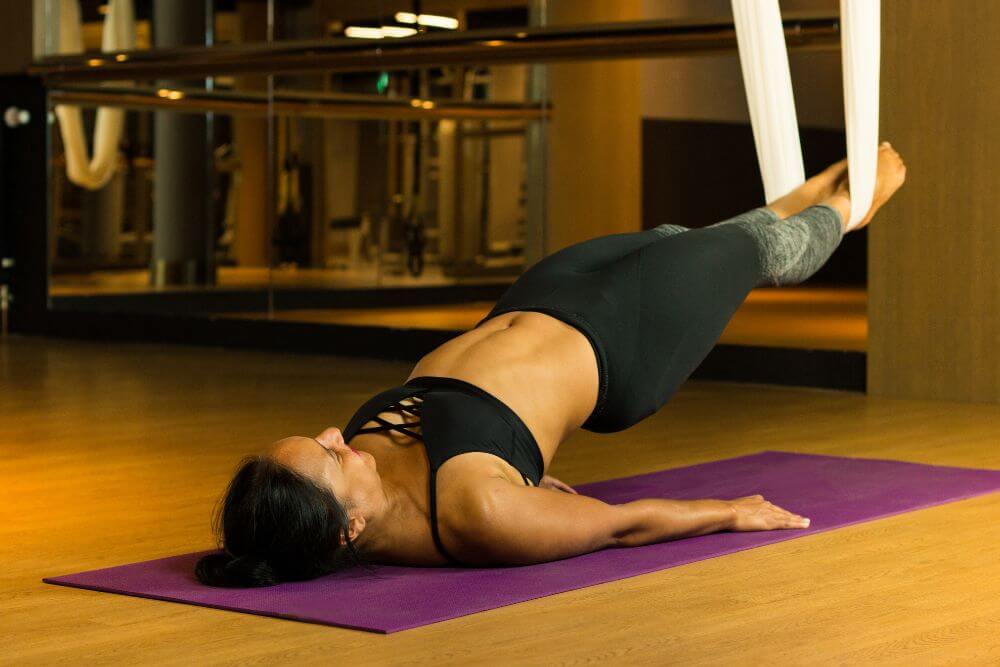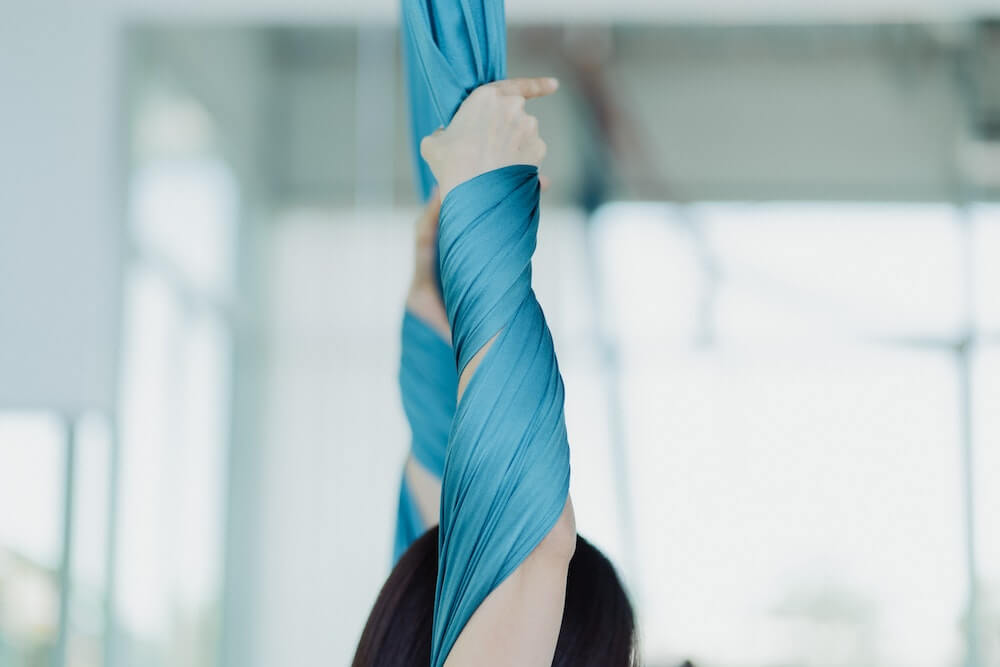Discover the ultimate Aerial Yoga Guide, where we answer some of the most common questions surrounding the practice.
Aerial Yoga offers a journey that defies gravity and elevates your yoga practice to new heights. The form of hammock-assisted yoga, has captured the hearts of yogis and fitness enthusiasts worldwide (including ours!).
Whether you’re a seasoned yogi or just spreading your wings, get ready to explore the world of aerial yoga as we delve into its techniques, safety tips, body benefits, and more.
What is Aerial Yoga?

Aerial yoga is a captivating blend of traditional yoga and acrobatics that invites practitioners to suspend themselves mid-air using soft fabric hammocks.
This unique practice allows for deeper stretches, creative inversions, and enhanced flexibility. Aerial yoga’s fabric hammocks act as versatile props that support your body weight and challenge your strength and balance.
Why is it Called Aerial Yoga?
The term “aerial” stems from the fact that this practice involves performing yoga poses while suspended in mid-air.
This dynamic fusion of yoga and aerial arts delivers a refreshing and transformative experience that takes your practice off the mat and into the air.
What is Another Name for Aerial Yoga?
Aerial yoga is sometimes called “anti-gravity yoga” due to its defying-the-norm approach. Much like the famous quote, “What goes up must come down,” anti-gravity yoga invites you to explore upward and downward movements, fostering a sense of freedom and playfulness.
Is Aerial Yoga Really Yoga?
There are a lot of traditionalists out there that don’t consider aerial yoga to be real yoga. While aerial yoga introduces an element of fun and excitement, it remains rooted in traditional yoga principles.
Breath awareness, mindfulness, and mental tranquility are core aspects of the practice. Many traditional yoga poses are done using the hammock, allowing you to extend your practice further.
Aerial Yoga vs Aerial Silks
While aerial yoga and aerial silks both involve suspended movements, they diverge in their primary focus.
Aerial yoga integrates yoga poses and flows within the fabric hammock, blending the benefits of yoga with the thrill of aerial arts.
On the other hand, aerial silks emphasize acrobatics and choreographed movements using two hanging fabric pieces.
What Do I Need to Know Before I Do Aerial Yoga?

Before taking flight, it’s useful to know more about the practice to ensure a safe and enjoyable aerial yoga experience.
Whether you’re a newbie or an experienced yogi exploring a new dimension, here’s a summary of what you can expect from aerial yoga.
Is Aerial Yoga for Beginners?
Aerial yoga is accessible to practitioners of all levels, including beginners. It’s an excellent way for newcomers to dip their toes into both yoga and aerial arts simultaneously.
The practice introduces fundamental poses and gradually builds the strength and confidence needed for more advanced techniques.
What Should I Wear to Aerial Yoga?
Your choice of attire plays a crucial role in your aerial yoga journey. Opt for form-fitting, comfortable clothing that allows for unrestricted movement. Avoid baggy outfits that could get caught in the fabric hammock, ensuring your practice is smooth and snag-free. For more information on this, check out our Clothing for Aerial Yoga Guide.
What Should I Eat Before Aerial Yoga?
Fueling your body adequately before an aerial yoga session is essential for sustained energy without discomfort. Aim for a light meal or snack about an hour before class. Choose easily digestible options that provide a balance of carbohydrates and protein, helping you stay energized throughout your practice.
Aerial Yoga Props Guide

Just like in traditional yoga, you’ll need props for aerial yoga. These are usually limited to an aerial hammock and a mat. But if you’re attending an Aerial Yin or Aerial Restorative class, you’ll also need bolsters and blocks.
Do I Need a Mat for Aerial Yoga?
We consider a yoga mat a necessity for aerial yoga. It helps to provide an extra layer of cushioning and grip for floor poses. However some students choose to practice without a yoga mat.
Do I Need My Own Hammock for Aerial Yoga?
You don’t need to invest in your own hammock to embark on your aerial yoga journey. Our yoga studio provides hammocks for rental, allowing you to access the experience without committing to props.
However, if you’re eager to deepen your practice at home or explore personal preferences, our aerial hammock buyer’s guide offers tips for making an informed decision.
What to Expect in an Aerial Yoga Class
Aerial yoga classes usually follow a structured sequence that ensures a balanced and invigorating practice. Here’s a breakdown of what to anticipate:
- Introduction: We will introduce you to the fabric hammock, covering safety guidelines and basic techniques.
- Warm-Up: Gentle movements and stretches prepare your body for the aerial challenges ahead.
- Strength and Stamina Exercises: Aerial yoga incorporates strength-building poses and movements that target various muscle groups.
- Inversions: Experience the thrill of aerial inversions, enhancing circulation and promoting relaxation.
- Cool Down: Wind down with calming stretches that help release tension and restore your body’s equilibrium.
- Savasana: The practice concludes with savasana, a period of deep relaxation to absorb the benefits of your aerial yoga session.
Aerial Yoga and the Body

Aerial yoga has a reputation for requiring both strength and flexibility. However, as with traditional yoga, adjustments can be made to make the practice accessible to all yogis.
What is the Weight Limit of Aerial Yoga?
Aerial yoga accommodates a range of body weights, with different studios and equipment having varying limits.
Generally, aerial hammocks can typically support individuals weighing up to around 250-300 pounds. It’s crucial to adhere to the guidelines provided by your studio to ensure a safe and enjoyable practice.
Can I Do Aerial Yoga if I’m Not Flexible?
Let’s get one thing straight – You don’t have to be flexible to do Aerial yoga. Hammock-assisted yoga is a fantastic avenue to enhance flexibility, regardless of your starting point.
The fabric hammock provides support, allowing you to ease into stretches and gradually work on increasing your range of motion.
How Do I Prepare My Body for Aerial Yoga?
Preparation for aerial yoga involves a combination of physical and mental readiness. Stay hydrated, stretch regularly, and focus on developing core and upper body strength. This preparation helps ensure you approach your aerial practice with confidence and minimize the risk of strain.
Your strength will improve with each class you attend, and the practice will become more accessible to you.
Who Should Do Aerial Yoga?

If you want to spice up your yoga practice, try something new, or improve your strength and flexibility, Aerial Yoga is for you. The yoga practice is suitable for beginners and experienced yogis alike.
What Are the Benefits of Aerial Yoga?
The benefits of aerial yoga are abundant, encompassing physical, mental, spiritual, and emotional dimensions.
- Enhanced Flexibility: Aerial yoga enables deeper stretches, facilitating increased flexibility over time.
- Strength Building: Maneuvering in the fabric hammock challenges various muscle groups, promoting overall strength.
- Mindfulness: The practice encourages mindfulness as you navigate movements, fostering a deeper mind-body connection.
- Stress Reduction: The inverted positions and focus on breath work aid in stress reduction and relaxation.
- Spinal Decompression: Aerial inversions provide gentle traction to the spine, relieving pressure and promoting spinal health.
We can’t cover all of the benefits in this aerial yoga guide, but we’ve got another post dedicated to the benefits of aerial yoga inversions.
Is Aerial Yoga Good for Anxiety?
Aerial yoga’s mindful and calming nature can be particularly beneficial for anxiety and depression. The practice encourages deep breathing, grounding techniques, and a heightened sense of present awareness, all of which contribute to anxiety relief.
Is Aerial Yoga Easier Than Yoga?
Aerial yoga offers a distinctive experience, not necessarily an easier one. While the fabric hammock provides support and assists with aerial yoga poses, it also introduces new challenges, such as learning to navigate mid-air movements and inversions.
As with any form of yoga, consistency, and practice are key to mastering the techniques. We always tell our students that aerial yoga doesn’t get easier; it gets better.
How Often Should You Do Aerial Yoga?
The frequency of your aerial yoga practice depends on your goals and schedule. Practicing 1-3 times a week can lead to visible improvements in strength, flexibility, and overall well-being. Consistency also helps reinforce muscle memory and deepen the mind-body connection.
Aerial Yoga Safety Guide

One of the most important elements of Aerial Yoga is safety. We want to make sure that your practice remains joyful and injury-free.
Who Should Not Do Aerial Yoga?
While aerial yoga is accessible to many, certain conditions and factors may warrant caution or medical clearance before participating. Individuals with the following conditions should consult a healthcare professional before attempting aerial yoga:
- Pregnancy
- High Blood Pressure
- Glaucoma or Retinal Conditions
- Recent Surgeries
- Heart Conditions
- Vertigo or Inner Ear Disorders
Is Aerial Yoga Safe for Kids?
Under proper supervision and guidance, aerial yoga can be a delightful and safe experience for kids. Children’s classes often emphasize playfulness, creativity, and basic poses tailored to their abilities and developmental stage.
Can I Fall Out of the Hammock?
While it’s possible to inadvertently slip or fall from the hammock, the risk is significantly minimized through proper instruction and adherence to safety guidelines.
As aerial yoga instructors, we will teach you how to keep secure and be confident in your movements.
Can You Do Aerial Yoga at Home?
With suitable equipment and familiarity with proper techniques, you can bring your aerial yoga practice into your home.
However, for beginners, we recommend you attend classes in a yoga studio to learn the basics and develop a solid foundation.
Risks and Common Injuries in Aerial Yoga
While aerial yoga offers numerous benefits, like any physical practice, there are potential risks to consider. Overexertion can lead to strains, and improper technique might cause muscle discomfort.
There is a possibility of falls, though, as we mentioned previously, we do everything we can to minimize this risk.
To mitigate the risk of injuries, it’s vital to learn proper alignment, progress at your own pace, and listen to your body.
It’s also worth noting that the hammock does provide deep pressure on the skin. It’s not uncommon to find bruises on your body from where the hammock has pressed. However, this is completely normal and nothing to be concerned about.
Side Effects of Aerial Yoga
After an aerial yoga session, it’s common to experience muscle soreness, fatigue, or mild dizziness due to inversions. These side effects are normal responses to trying a new form of exercise and should dissipate with rest and hydration.
We recommend drinking lots of water after your aerial yoga practice.
Note: Other side effects include exhilaration and increased energy.

Got Any More Questions About Aerial Yoga?
Aerial yoga is an extremely unique practice. We’ve tried to cover the most commonly asked questions with this aerial yoga guide, but if you’ve got any more questions, we’d love to answer them!
We’re always happy to chat with you after our yoga classes. Otherwise, you can reach out to us via email or our contact page.




